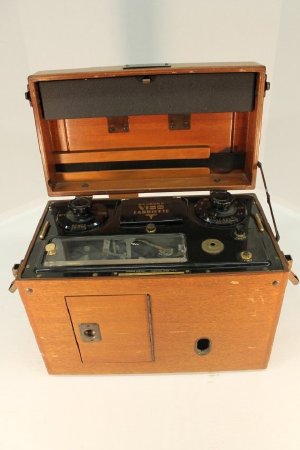Object ID Number:
2017.015.001
Object Name:
Electrocardiograph Machine
Type:
EKG Machine
Manufacturer:
Sanborn, Cambridge, MA
Date of Manufacture:
/ /
Manufactured from:
1939
Manufactured to:
1950
Description / History:
This EKG machine comes in a portable wooden case that made it available for travel. Inside the case are two dials used to operate the machine as well as the glass covering on the printable paper recording of the EKG. This machine can carry up to 115 volts, 60 cycles, and 85 amps. It was manufactured by the Sanborn Company in Cambridge, MA. The machine is the company's model 51 and serial number 1840, and has the US patent number 2180160 documented on the machine. This patent was filed March 26, 1937 by Arthur Miller and created to record the electrical current in a similar means to the action of the heart. He created a formula to get a corrective value, making the machine much more accurate to the actual pattern of the heart.
Dimensions:
H–11.5 W–8.25 L–14 inches
Additional Information:
Electrocardiograms (EKGs)
An electrocardiogram (also called ECG or EKG) is a noninvasive test that records the electrical activity of the heart. This examination is useful because, with each heartbeat, an electrical signal spreads from the top to the bottom of the heart. As this electrical signal travels, it induces the heart to contract, and to pump blood throughout the body. Since the heart's electrical signals determine the rhythm of the heartbeat, an EKG can be used to show how quickly the heart is beating, whether the heart's rhythm is steady or irregular, and how strongly the electrical signals pass through each part of the heart. Based on these readings, a physician may discover a number of conditions, such as arrhythmias or recent heart attacks, and may also monitor the functioning of implanted pacemakers.
The earliest electrocardiogram was designed in 1901 by William Einthoven, a scientist from the Netherlands. In Einthoven's design, currents from the heart's electrical signals were carried down a silver coated glass conducting wire which was suspended between two electromagnets. The fluctuations of the wire as a result of the changing electrical currents were transcribed onto a photographic plate and produced readouts similar to those given by modern EKGs (although Einthoven's machine weighed 600 pounds, took up two rooms, and needed five people to operate).
EKGs remain one of the most important diagnostic tools today, and in 2011, 82,707 EKGs were performed at Lancaster General Hospital (or affiliated healthcare institutions), which amounts to a staggering 226 per day.
An electrocardiogram (also called ECG or EKG) is a noninvasive test that records the electrical activity of the heart. This examination is useful because, with each heartbeat, an electrical signal spreads from the top to the bottom of the heart. As this electrical signal travels, it induces the heart to contract, and to pump blood throughout the body. Since the heart's electrical signals determine the rhythm of the heartbeat, an EKG can be used to show how quickly the heart is beating, whether the heart's rhythm is steady or irregular, and how strongly the electrical signals pass through each part of the heart. Based on these readings, a physician may discover a number of conditions, such as arrhythmias or recent heart attacks, and may also monitor the functioning of implanted pacemakers.
The earliest electrocardiogram was designed in 1901 by William Einthoven, a scientist from the Netherlands. In Einthoven's design, currents from the heart's electrical signals were carried down a silver coated glass conducting wire which was suspended between two electromagnets. The fluctuations of the wire as a result of the changing electrical currents were transcribed onto a photographic plate and produced readouts similar to those given by modern EKGs (although Einthoven's machine weighed 600 pounds, took up two rooms, and needed five people to operate).
EKGs remain one of the most important diagnostic tools today, and in 2011, 82,707 EKGs were performed at Lancaster General Hospital (or affiliated healthcare institutions), which amounts to a staggering 226 per day.
3D Image Information:
The 3 dimensional image can be viewed using Google Chrome, Safari, or Firefox browsers.
3 Dimentional Image:
